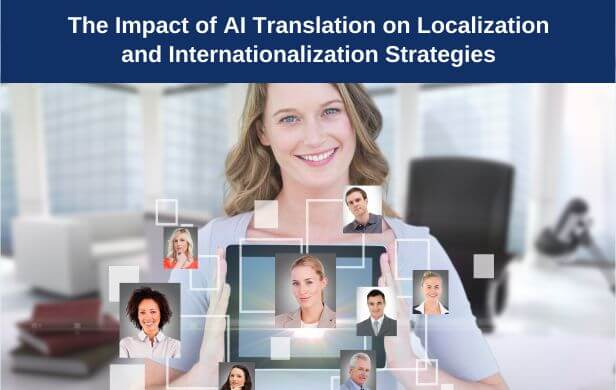
In today's digital world, businesses are expanding their reach across borders and language barriers. Localization and internationalization strategies play a crucial role in ensuring that products and services meet target markets' cultural and linguistic preferences. However, the rapid advancement of artificial intelligence (AI) translation technology is revolutionizing how companies approach localization and internationalization.
This blog explores the profound impact of AI translation on these strategies and highlights the opportunities and challenges it presents.
AI has proven to be useful in an infinite number of scenarios, including the translation sector. AI and machine translation help consumers save money and time. Neural Machine Translation (NMT) is the most widely utilized and advanced form of AI. NMTs use deep learning to improve translation quality. They recognize trends in words, sentence structure, and intent, which are used to give more personalized results.
AI translation has significantly increased efficiency and reduced costs in the localization process. With traditional translation methods, companies had to rely on human translators, who were time-consuming and expensive. AI translation tools, on the other hand, can analyze vast amounts of data and generate translations at a fraction of the time and cost. This enables businesses to streamline their localization efforts, accelerate time-to-market, and allocate resources more effectively.
While early iterations of AI translation were often criticized for their inaccuracies and lack of contextual understanding, recent advancements have greatly improved translation quality. Neural machine translation (NMT) models, powered by deep learning algorithms, have enhanced the ability of AI to produce more accurate and contextually appropriate translations. After human review, this enables delivering localized content that resonates with target audiences, leading to better customer experiences and higher conversion rates.
AI translation technology offers scalability in localization and internationalization efforts. Whether it's translating product descriptions, user manuals, or software interfaces, AI can easily handle large volumes. This level of scalability is important for companies expanding into multiple markets simultaneously, enabling them to maintain a unified brand image across different languages.
AI translation has broadened the possibilities for localization, allowing companies to target new markets that were previously challenging to penetrate. By leveraging AI-powered tools, businesses can quickly translate their content into multiple languages, and with human review, it gives them a competitive advantage in global markets. This expanded localization reach opens doors to untapped customer bases and unlocks new revenue streams for companies willing to embrace AI translation technology.
Language is deeply intertwined with culture, and effective localization goes beyond mere translation. Here is where human translators become crucial in revision of the machine translation to enable businesses to adapt their content to local preferences, creating a more personalized and engaging user experience. By leveraging AI to navigate cultural differences, companies can establish stronger connections with international audiences and foster brand loyalty.
The most obvious advantage of adopting AI and machine translation is that it can dramatically improve language translation speed. Translation was a time-consuming and expensive procedure requiring human translators to manually translate material from one language to another. Machine translation, on the other hand, can translate enormous amounts of text fast and precisely, lowering the time and cost required to communicate across language barriers. Such a machine translation process is acceptable for content which is not to be published or used for crucial purposes like medicine or law or making business decisions, for example.
Another key benefit of AI and machine translation is the ability to translate a large range of languages. While human translators are frequently limited by their knowledge and competence in certain languages, AI and machine translation may be taught to translate hundreds of languages fast, making cross-cultural communication much easier.
While the benefits of AI translation are significant, there are still challenges and considerations that businesses must address:
Quality Assurance: Although AI translation has improved, it is not flawless. Professional translations still need human checking and post-editing to ensure accuracy and linguistic quality.
Privacy and Data Security: AI translation relies on vast amounts of data, including sensitive information. Companies must ensure robust data protection measures are in place when they decide to use machine translation services of a particular organisation, to maintain user privacy and comply with data regulations.
Linguistic and Cultural Nuances: AI translation may struggle with highly specialized or industry-specific terminology and intricate cultural references. Companies must carefully review and adapt translations to ensure they align with local customs and preferences.
Ethical Considerations: AI translation raises ethical concerns about bias, censorship, and potential misuse. Businesses must employ responsible AI practices and ensure transparency in their translation processes.
By employing these strategies, language bureau services can overcome challenges, deliver accurate translations, and provide value-added services to our clients.
Conclusion:
AI translation technology has revolutionized localization and internationalization strategies, offering enhanced efficiency, scalability, and expanded reach. As businesses continue to expand globally, embracing AI translation becomes a competitive necessity. However, it is crucial to acknowledge the limitations and address the challenges associated with AI translation, maintaining a balance between automation and human expertise.
For any queries related to language translation services. Inquire at our email address below or give us a call today!
info@languageservicesbureau.com
Telephone: +91-20-24470509, +91-82370 60559
Similar articles for you...

आमच्या गेल्या महिन्यातील ब्लॉग मध्ये भाषांचे ज्ञान आवश्यक असणाऱ्या करियर क्षेत्रांची माहिती आपल्याला मिळाली. जिथे भाषेचे ज्ञान फायद्याचे ठरते असे इतर व्यवसाय आपण या महिन्यात पाहुयात.

Posted by : Language Services Bureau

The time it takes to learn a language depends on what you want to do with it– here is a great article about language learning and the kind of expectations you can set about the time required for the same!